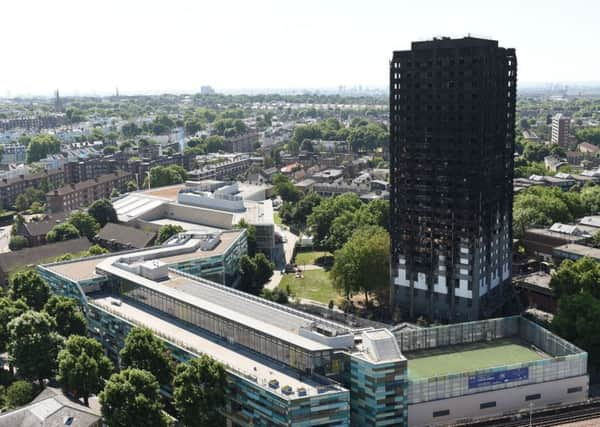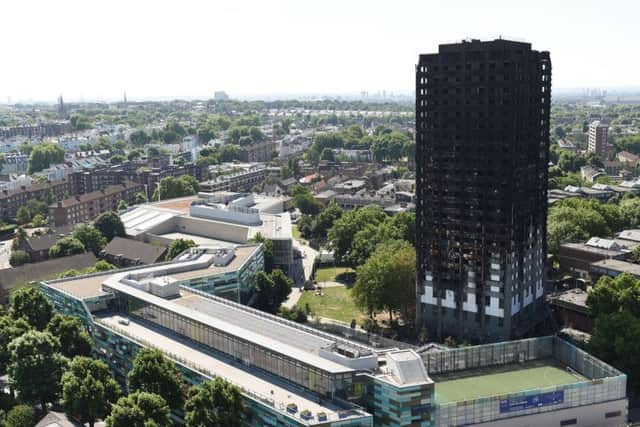Jayne Dowle: Six months on, Grenfell stands witness to failure


It was hardly a jolly sightseeing tour. Too much has happened this year for that. Heading towards the River Thames from Brixton, we couldn’t avoid Southwark and London Bridge, where eight people were killed and 48 injured by a terrorist attack on that Saturday night in early June.
As I reflected on this most tragic of summers in a city I was once proud to call my home, I hesitated. Should we divert west towards Kensington and bear witness to the blackened 24-storey ruin of Grenfell Tower? Or should we turn our backs and think quietly about the 71 souls who perished six months ago today?
Advertisement
Hide AdAdvertisement
Hide AdI’m not one to shy away from tragedy, but there is something about Grenfell which disturbs me deeply. I can’t even watch the news footage of the fire taking hold. It’s not just because this particular tragedy was preventable.


It’s not even because so many children died, terrified and clinging to their parents for safety, although this aspect is totally heartbreaking. It’s because the roll call of residents who lost their lives, lost their families and lost everything they owned tells us some terrible truths about the society we all live in.
What has happened in the six months after the event tells us even more. The long-awaited public inquiry into the disaster reopened this week, so we are set to find out more about the reasons why the fire took hold and spread so quickly.
However, without prejudicing any verdict, it is probably fair to say that the refurbishment of the building in 2014 over-rode local concerns about fire-resistant cladding. The residents wanted zinc, it’s reported, as this material is regarded as safer in a fire. But to save £300,000 the management company, Kensington and Chelsea Tenant Management Organisation (KCTMO), opted for aluminium with a polyethylene core, which has since proved combustible in Government tests.
Advertisement
Hide AdAdvertisement
Hide AdWhat’s the point of asking residents what they want and then ignoring their concerns? This is the key question which remains hanging in the air like the smell of acrid smoke which shrouded North Kensington.


In the immediate aftermath of the tragedy, the Prime Minister promised rapid help for the victims. She also assured the millions of people living in social housing tower blocks in the UK that provision would be made to install sprinklers where none were fitted.
Now, in a volte-face which beggars belief, local council after local council reports that there is no central government money forthcoming to provide this life-saving measure. During a bitter debate in the House of Commons, Mrs May told concerned backbenchers that it is “up to the council to make decisions”. In other words, if local authorities can’t find the cash to do the job, millions of lives will remain at risk from the spread of fire with no means of escape.
Can anything underline more acutely the entire sense of disconnect which the Government has exhibited over Grenfell and its aftermath? This callous disregard for human life shocked London fire brigade chief Dany Cotton, who says she is “staggered” that sprinklers are not fitted as standard in such buildings.
Advertisement
Hide AdAdvertisement
Hide AdWhat has been lacking since the day after the fire wreaked havoc is effective leadership. Where was the disaster committee, the expert put in charge of co-ordinating rehousing and rehabilitation? The Government has effectively turned its back and left the local council in North Kensington to get on with sorting out the mess. And that council has been riven with discord and resignations, while survivors try to survive, still living in overcrowded hotel rooms months after they lost their homes.
If you think that not acting on expert advice and not ordering sprinklers to be intstalled in every susceptible building is bad practice, it is nothing compared to the lack of care which has been given to the hundreds left homeless by the tragedy.
To his credit, Labour leader Jeremy Corbyn has refrained from making too much political capital out of personal loss. However, speaking in response to Chancellor Philip Hammond’s assertion that local councils must take responsibility for fitting sprinklers, his words rang true. He said: “The horrors of Grenfell Tower are a reflection of a society which put profits before people, that fails to listen to working-class communities.” When that haunting skeletal wreck has finally been clad and traumatic memories start to eventually recede, this will be the Government’s legacy.
Last weekend then, instead of heading west, I turned the car towards the East End and we headed for the M11 and home. Along the Mile End Road, tower blocks loomed up on every side. Each flat a home for someone. A person with dignity, belongings, memories. Even though we were heading in the opposite direction, the shadow of Grenfell Tower fell long in the evening light.